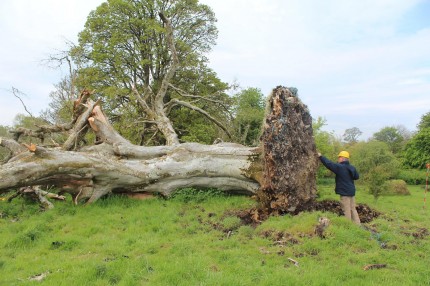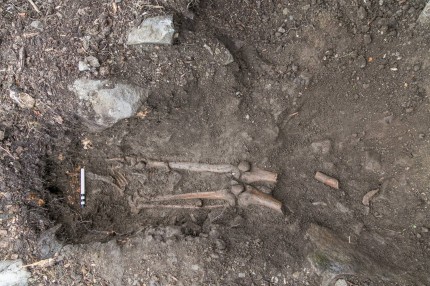
The newly established Sligo-Leitrim Archaeological Services (SLAS) had a fasinating first commission: to recover skeletal remains torn out of the ground when a tree was uprooted during a storm.
The beech tree had stood outside Collooney, County Sligo, Ireland, for 215 years before a storm blew it down last winter, pulling out the roots and the top half of a skeleton with them. The body was snapped in two when the tree toppled, leaving both femurs broken while the lower legs remained undisturbed in the grave. The National Monuments Service hired SLAS to excavated the remains in the ground and to painstakingly remove the bones embedded in the tree’s root matrix. The found part of the skull and spine in the roots, but other bones were destroyed by the roots as the tree grew.
Preliminary analysis of the bones by osteoarchaeologist Dr Linda Lynch revealed that the deceased was a young man 17-20 years old when he died. Radiocarbon dating found he was buried between 1030 and 1200 A.D. While a strapping 5’10” tall in a time when the average height was 5’5″, the youth suffered mild spinal joint disease likely caused by heavy physical labour from a young age. There is evidence on the bones that he did not die an easy death. Sharp force injuries on the ribs and hand point to his having been cut repeatedly with a knife or sword.
He was given a formal Christian burial. His grave was aligned east-west and he was placed in the grave with his hands folded over his pelvic region. There are records from the 19th century that describe a church and graveyard nearby, but no other human remains or archaeological evidence of a church were found during the excavation. Also, the tree was planted in 1800, so any graveyard in the environs of the medieval body probably wasn’t in its immediate surroundings. He may have been an isolated burial rather than one of many buried in a cemetery.
The skeletal remains will studied in more depth and post-excavation work on the site continues.

Obviously, a case of ‘resurrection by tree’.
It seems BTW as if, at least when taking the Interweb and ol’ Ptolemy into account, that Ballysadare/ Sligo was already ‘known to Greek, Phoenician and Roman traders’, but was also a late Viking or Norman settlement.
Apart from that, I suppose the use of medieval metrics here is meant to honour the deceased: 5ft+10inch = 177.8 cm, whereas 5ft+5inch = 165.1 cm.
I have found artifacts in upturned root balls before, arrowheads, bits of worked stone. I can’t walk by one in the woods without giving it the once over.
For some reason I was initially picturing the body as having been oriented vertically so that the top two thirds were entangled in roots, leaving the lower third in the soil when the tree went over. ^___^
Haha I did too.
Reminds me of a fascinating tale I was once researching about skeletons found inside logs in South Eastern Victoria in Australia. There is an indigenous custom to bury dead in trees, but these were mostly early European settlers bones found in and under trees and stuffed inside logs. Don’t think the mystery was ever fully solved.
Alternate headline: Jimmy Hoffa Found!